- Home
- Richard F. Weyand
Campbell- The Problem With Bliss
Campbell- The Problem With Bliss Read online
THE PROBLEM
WITH BLISS
by
RICHARD F. WEYAND
Copyright 2018 by Richard F. Weyand
All Rights Reserved
ISBN 978-1-7321280-3-3
Printed in the United States of America
Cover Credits
Model: selfie by Matt Shute
Background: Gang Zhou
Composition by: Oleg Volk
Back Cover Photo: Oleg Volk
Books in the Childers Universe
Childers
Childers: Absurd Proposals
Galactic Mail: Revolution
A Charter For The Commonwealth
Campbell: The Problem With Bliss
Published by Weyand Associates, Inc.
Bloomington, Indiana, USA
October, 2018
CONTENTS
First Incursion
En Route
Arrival
Preparations
Bliss
Checking In
Getting Started
On Patrol
Lines of Inquiry
A Little Matter Of Death
Follow the Money
Interviews Begin
More Interviews
Correlation
Briefing
Disclosure
Paydirt
Chameleon
Return To Bliss
Red Navy
The Patience Of A Cat
Extreme Prejudice
Undisguised
Duval
Clean-Up
Departure
Second Incursion
Hutan
Appendix
Acronyms and Terms
First Incursion
Captain Tien Jessen, commanding the Commonwealth Space Force destroyer CSS Whittier, was not happy.
As the commanding officer of the destroyer squadron’s second division, he had inherited squadron command for the time being. The division commander, Senior Captain Jasmine Carruthers, was down sick back on Bliss, and her flagship, the CSS Knox, was being commanded by her executive officer.
The squadron’s assignment was to protect the precious metal mining operations on Bliss-6c, the third largest moon of one of the system’s gas giants. This would normally be an assignment for larger ships, but they were all off practicing maneuvers around Bliss. The Waldheim massacre over a year ago had made planetary commanders more sensitive to the need to periodically drill their commands.
Jessen felt vulnerable, with eight small ships on the other side of the system from the populated planet Bliss-2 and the larger forces for which the destroyers usually acted as pickets. He had made what plans he could, and now it was just sit and wait.
Hopefully nothing would happen before the exercises were over and their normal patrols were re-established.
“Hyperspace transition complete,” Duval Space Navy Lieutenant Henry Ambrogi said.
“We’re collecting data now, Sir,” Lieutenant Commander Debra Hansen said. “We have multiple warships – at least three squadrons – active around Bliss. Hard to make it all out at this distance.”
“And what about Bliss-6?” asked Rear Admiral Frank Stenberg, commanding the light cruiser division from his flagship, the DSN Solar Wind.
“We have eight ships at standby power levels in orbit around the gas giant, Sir. No class determination possible yet.”
“Keep an eye on them, Commander. I want to know what they are as soon as they power up.”
“Yes, Sir.”
“Let’s get under way, Mr. Ambrogi. Division orders. Set course for Bliss-6c at 1.7 gravities.”
“Sir, we have a hyperspace transition at zero mark zero-nine-zero on Bliss-6,” Lieutenant Theresa Sato said. “Right on the system periphery. Four warships, Outer Colony design. I make them as light cruisers. Beginning acceleration toward Bliss-6 at 1.7 gravities.”
“Squadron orders,” Jessen said. “Spacing Plan Green-1. Power up per Spacing Plan Green-1 and set course zero mark zero-nine-zero on Bliss-6.”
“Spacing Plan Green-1 on course zero mark zero-nine-zero on Bliss-6. Orders transmitted, Sir.”
“They’ve powered up, Sir,” Hansen said. “I make it eight destroyers. Coming out to meet us at 1.4 gravities.”
“1.4 gravities?” Stenberg asked.
“Yes, Sir. 1.4 gravities.”
Stenberg’s chief of staff, Captain Maryanne Caro, came up alongside him. “What do you make of that, Sir?”
“I’m not sure what to make of it. If that’s really eight destroyers, they have a lot of steel to be coming out after four light cruisers. Then again, nobody ever said the Commonwealth navy was full of faint-hearts. But 1.4 gravities doesn’t make any sense. If they’re really destroyers.”
“You suspect a disguise, Sir?”
“The one thing you can’t disguise is acceleration, Maryanne. If they can only make 1.4 gravities, they’re not destroyers.”
Stenberg considered for a moment.
“Commander Hansen, keep a really close eye on those destroyers. I want to make sure they’re what we think they are.”
“Yes, Sir.”
“We’ve been under way for half an hour now, Sir,” said Commander Sean Medved, Jessen’s executive officer.
“That should be long enough. Let’s let them see through the disguise a bit. Division orders, Second Division. Begin Option Leak-Through.”
“Sir, I’ve seen some energy anomalies with the Commonwealth destroyers,” Hansen said. “Marking them on the plot.”
Small red circles appeared around four ships in the oncoming destroyer formation in the plot.
“Those four ships, they’ve had some power bleed-throughs, Sir. Not destroyer power levels. They’re well up into heavy cruiser range.”
“Could that be a disguise?” Stenberg asked.
“Unlikely, Sir. Generating a power signature that big from a destroyer, they risk blowing their power plant. Pretty big risk, actually.”
“What do you think, Maryanne? A disguise, or is that a division of heavy cruisers with a division of destroyers along for the ride?” Stenberg asked his chief of staff.
“You know, now that those four ships are marked, Sir, that looks suspiciously like a CSF heavy cruiser formation. Look at the separations and the orientation. The destroyers were covering it.”
“That’s what I think, too. I should have known they wouldn’t leave Bliss-6c uncovered for their exercises. Well, higher told me if this wasn’t going to be a cakewalk, to come on home and not get ourselves all shot up. I don’t consider messing with a division of Commonwealth heavy cruisers to be a cakewalk. Commander Hansen, division orders. Let’s flip ship and get out of here.”
“Yes, Sir. Orders transmitted.”
“They’ve flipped ship, Sir,” Lieutenant Sato said. “They’re making for the system periphery.”
“Maintain status,” Jessen said.
Medved came up alongside Jessen.
“We’re pushing our power plants pretty hard, Sir.”
“We need to keep it up until they transition, Sean. I don’t want them coming back in on us.”
“I hope we all hold together.”
“That’s it, Sir,” Lieutenant Sato said. “They’ve transitioned out of the system.”
“Division orders. Stand down Option Leak-Through. Shut down engines. Assess damage. Begin repairs.”
“Sir, the Elmhurst reports her power plant is failing. They’re going to lose it. They’re abandoning ship.”
“Squadron orders. All ships launch shuttles to assist evacuation of the Elmhurst. Let’s get our people out of there.”
It took over an hour to g
et everyone off the Elmhurst. Somehow the senior chief in the engine control room kept the thing together until they could all get off. He was on the last shuttle to leave, and fifteen minutes later, the Elmhurst exploded when her power plant let go.
The Bennington had the opposite problem. When they shut the engines down, they couldn’t get them restarted. Her poor engines had had enough, and she wasn’t going anywhere. They abandoned the Bennington, and it continued to drift across the system until it could be retrieved.
The remaining six destroyers of Jasmine Carruthers’ squadron returned to station under Jessen’s command.
“Go right on in, Captain. She’s expecting you,” said Lieutenant Commander Rita Allyn, Admiral Mary Rao’s secretary.
“Thank you, Commander.”
Jessen entered the planetary commander’s office at Bliss Fleet HQ.
“Ah, there you are, Captain. Be seated, please.”
“Thank you, Ma’am.”
“Captain Jessen, I wanted to thank you personally for your actions in response to the recent incursion attempt. The previous two attempts at Bliss-2 were apparently feints to make us think Bliss-6c wasn’t their actual target. My exercises, while important to keep us on our toes, left us weakly covered on Bliss-6c. My fault. But your actions nullified my mistake and saved considerable damage to the system’s infrastructure. I can’t thank you enough.”
“Thank you, Ma’am.”
“I’ve characterized your actions as a combat action, so you should receive the Combat Medal and your crews should all receive the Victorious Action ribbon. I also put in for the Distinguished Service Medal for Senior Chief Strnad for holding the Elmhurst together while his shipmates got off. That’s all up to the Merit Review Board, but I put in for them. I have also characterized the loss of the Elmhurst and the Bennington as engineering failures after the combat action was over, so there will be no Board of Inquiry into their loss.”
“Thank you, Ma’am. That’s very kind of you.”
“Not at all, Captain. That was a fine piece of work out there. You saw the position you were in – the position I put you in – and came up with a plan to respond in advance of the action. That plan worked, and saved significant lives and infrastructure against a hostile incursion. And in carrying out that plan, you put yourself at risk in ordering the Second Division to run so heavily disguised.”
“Only Second Division had practiced that particular option, Ma’am.”
“Because, as Second Division commander, you had seen to it that it was part of their repertoire. Yes, Captain, I know. For all those reasons, I have also put you in for the Distinguished Service Medal. It’s up to the Merit Review Board, but I don’t think they’ll have a problem with that one.”
“Yes, Ma’am. Thank you, Ma’am.”
“You’re very welcome, Captain. And thank you again. Dismissed.”
En Route
Rear Admiral Jan Childers and her listed companion, Senior Captain Inspector William Campbell, were in Childers’ ready room next to the flag bridge on the CSS Patryk Mazur. Childers’ heavy cruiser squadron had just departed Meili and was on its way to the northern system periphery at zero mark zero-nine-zero on the planet.
“OK, so Meili is done. I think that one went well,” Childers said.
“Went well for me, too. The intelligence group here is pretty well buttoned down. It was nice to see such a well run organization.”
“As opposed to Natchez.”
“As opposed to Natchez.” Campbell sighed. “What a waste of resources. We’re lucky we haven’t had more problems there than I turned up.”
“That you know of, anyway. So what’s to be done?”
“I sent my report in to Sigurdsen before we left orbit. My guess is Admiral Birken will replace the planetary intelligence chief. And the new guy is going to have to bring in some of his own staff to really get it all cleaned up.”
They were one year into the Grand Tour, in which they went from planet to planet, with Jan Childers and her staff training up and drilling the local Commonwealth Space Force squadrons in the standard Fleet Book of Maneuvers. While she did that, Bill Campbell did an assessment of the Intelligence Division’s operations in the system. Waldheim, Courtney, Natchez and Meili were done, with Bliss, Hutan, Mountainhome, and Shaanti to go.
Jan Childers at this point was thirty years old and had been in the Commonwealth Space Force for sixteen years. Bill Campbell was thirty-three, and had been in the CSF since graduating the Academy thirteen years before. They had listed themselves as companions with the CSF, which got them consideration in assignments and housing, for the last six years.
“So, Bliss is next. What do we know about Bliss?” Childers asked.
“Well, Bliss has always been pretty quiet, from a CSF point of view,” Campbell said. “It’s not a big commercial powerhouse. They have increased their deep-space precious metals mining operations significantly over the last ten years, though, and their Outer Colony competitors have been complaining about unfair competition. That’s gotten them a little more action lately.”
“What kind of action?”
“Three incursion attempts. Local CSF forces ran them off without any actual combat. Didn’t get good IDs on the attackers, though.”
“I’ll be interested to get more details on those when we get there,” Childers said.
“Me, too.”
“It’s three weeks’ crossing to Bliss, so I guess we’re just going to have to wait to learn more.”
The Patryk Mazur and her consorts transitioned into hyperspace, and the trip settled into the weeks-long hyperspace transit with which spacers were familiar.
Even at forty-thousand times the speed they could achieve in normal space, interstellar distances were unimaginably huge. The forty-light-year transit from Meili to Bliss would take three weeks in hyperspace, in addition to the time spent spacing to and from the system periphery at either end. Hyperspace travel within the system periphery was not possible, resulting in the destruction of the ship, especially during hyperspace transition. The ship just came apart, like it was being stretched until it literally popped at the seams.
Shipboard life settled into boring routine. The ships maintained one gravity of acceleration throughout the trip, flipping over halfway, so at least there wasn’t any weightlessness involved except during the flip. There was lots of free time, though, and the ships’ large libraries of virtual reality recordings got extensive use by the crews.
Jan Childers and Bill Campbell, though, were studying up on the situation on Bliss and the reports and personnel files of the senior officers, with Childers concentrating on the line officers of the CSF forces assigned to defend the system, and Campbell concentrating on the Intelligence Division staff officers assigned to the Bliss Planetary Intelligence Headquarters.
Arrival
“Hyperspace transition complete, Ma’am.”
“Is our welcoming party here?” Jan Childers asked.
“Yes, Ma’am. CSS Hannibal and CSS Akbar are standing by at fifteen light-seconds, one-eight-zero mark zero on the ship.”
“Send arrival announcement. Navigation Plan Red-2 to twenty miles.”
“Ma’am, hyperspace transitions at zero mark zero-nine-zero on the planet, on the system periphery. Distance fifteen light-seconds at zero-mark-zero on the ship. Four contacts. They’re warships, Commonwealth design. I make them to be heavy cruisers,” Lieutenant Anish Krueger said.
“Admiral Childers. Right on schedule,” said Vice Admiral Vina Novotny, commanding her battleship squadron aboard her flagship, the CSS Hannibal.
“Yes, Ma’am. We just received their arrival announcement.”
“Well, now the fun really starts.”
“Hyperspace transition, Ma’am. They’ve all transitioned out.
“Maintain status.”
“Hyperspace transition, Ma’am. The four heavy cruisers are now directly ahead, at zero-mark-zero on the ship, distance twenty miles.”
“Well, that’s impressive. Launch shuttles.”
“They’re unfolding cylinders now, Ma’am.”
“Get me a comm channel to Admiral Childers.”
“Admiral Childers. Welcome to Bliss.”
“Thank you, Admiral Novotny. It’s good to be here.”
“We’ve launched our shuttles to pick up your passengers.”
“We’ll clear our shuttle bays and have the passengers ready to go as soon as we can spin up some gravity over here, Admiral. The instructors are all ground-pounders and it’d be no fun getting them aboard in zero-g.”
“Understood. I have to tell you, Admiral Childers, we’re all looking forward to the training and drills. We’ve had reasons to believe recently that we need it.”
“So I understand, Admiral. I’ll be looking forward to meeting you to learn about some of those incidents once the classroom portion is complete and I can get down to Bliss.”
“I’ll send you the most recent classified reports for your study in the meantime.”
“Thank you, Admiral. In the meantime, we have patrol duties and your squadron stands relieved.”
“Thank you, Admiral Childers. See you in a couple of weeks then. Novotny out.”
Childers’ heavy cruisers folded their crew cylinders out perpendicular to the long axis of the ship, and then spun the ships to provide artificial gravity in the crew spaces. Under way, those cylinders folded back parallel to the long axis of the ship, and artificial gravity was provided by the ship’s acceleration.
Once spun up, one of the shuttles latched to the racks on the bow of the each ship released and moved away from their ship, opening up a shuttle rack for Novotny’s inbound shuttles. The shuttle racks on the bow of the ships were counter-rotated so the racks were stationary.

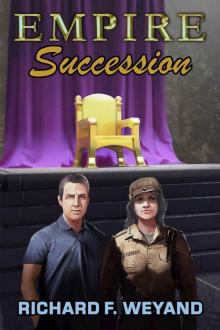 EMPIRE: Succession
EMPIRE: Succession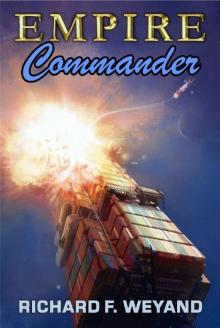 Commander
Commander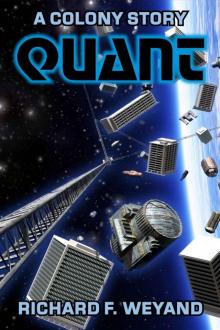 QUANT (COLONY Book 1)
QUANT (COLONY Book 1) EMPIRE: Renewal
EMPIRE: Renewal GALACTIC SURVEY (COLONY Book 3)
GALACTIC SURVEY (COLONY Book 3) Campbell- The Problem With Bliss
Campbell- The Problem With Bliss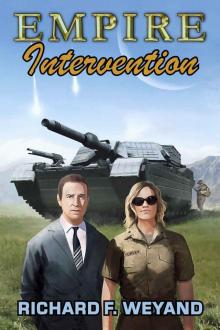 EMPIRE: Intervention (EMPIRE SERIES Book 13)
EMPIRE: Intervention (EMPIRE SERIES Book 13)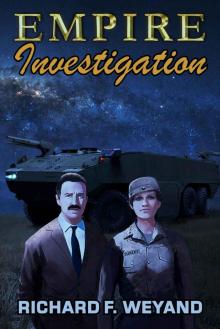 EMPIRE: Investigation
EMPIRE: Investigation A Charter for the Commonwealth
A Charter for the Commonwealth EMPIRE: Resistance
EMPIRE: Resistance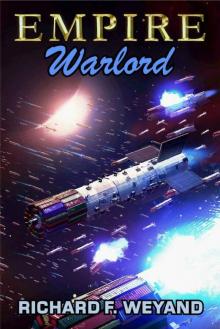 EMPIRE: Warlord (EMPIRE SERIES Book 5)
EMPIRE: Warlord (EMPIRE SERIES Book 5) EMPIRE: Resurgence
EMPIRE: Resurgence EMPIRE: Conqueror (EMPIRE SERIES Book 6)
EMPIRE: Conqueror (EMPIRE SERIES Book 6)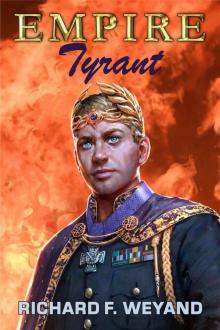 Tyrant
Tyrant Usurper
Usurper Galactic Mail: Revolution! (Childers Universe Book 3)
Galactic Mail: Revolution! (Childers Universe Book 3) Galactic Mail_Revolution!
Galactic Mail_Revolution! Childers
Childers CHILDERS_Absurd Proposals
CHILDERS_Absurd Proposals